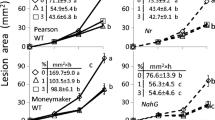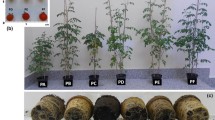Abstract
Trans-2-hexenal is a biocidal molecule released in many fruits and vegetables. In this paper, the effects of trans-2-hexenal on the control of postharvest diseases in tomato fruits were investigated. We indicated that the incidence of natural infection and infection by Botrytis cinerea in tomato fruits was significantly decreased after treatment with trans-2-hexenal. Trans-2-hexenal increased the mRNA levels of genes encoding ethylene receptors, lipoxygenase and phenylalanine ammonia lyase (PAL), but did not induce the mRNA accumulation of the pathogenesis-related proteins, such as PR-1a or PR-5. The activities of peroxidases and PAL and the accumulation of phenolic compounds were significantly enhanced after trans-2-hexenal treatment. This is the first report of trans-2-hexenal as an elicitor and its ability to control the postharvest diseases in tomato fruits. These results suggest that the controlling effects of trans-2-hexenal on both natural infection and gray mould in tomato fruits might be related to JA/ET-mediated induced systemic resistance.





Similar content being viewed by others
References
Assis JS, Maldonado R, Muñoz T, Escribano MI, Merodio C (2001) Effect of high carbon dioxide concentration on PAL activity and phenolic contents in ripening cherimoya fruit. Postharvest Bio Technol 23:33–39
Bate NJ, Rothstein SJ (1998) C6-volatiles derived from the lipoxygenase pathway induce a subset of defense-related genes. Plant J 16:561–569
Ciardi J, Harry K (2001) Regulation of ethylene-mediated responses at the level of the receptor. Ann Bot 88:813–822
Ciardi JA, Tieman DM, Lund ST, Jones JB, Stall RE, Klee HJ (2000) Response to Xanthomonas campestris pv. vesicatoria in tomato involves regulation of ethylene receptor gene expression. Plant Physiol 123:81–92
Corbo MR, Lanciotti R, Gardini F, Sinigaglia M, Guerzoni ME (2000) Effects of hexanal, trans-2-hexenal, and storage temperature on shelf life of fresh sliced apples. J Agric Food Chem 48:2401–2408
de Capdeville G, Beer SV, Watkins CB, Wilson CL, Tedeschi LO, Aist JR (2003) Pre- and post-harvest harpin treatments of apples induce resistance to blue mold. Plant Dis 87:39–44
De Lucca AJ, Carter-Wientjes CH, Boue S, Bhatnagar D (2011) Volatile trans-2-hexenal, a soybean aldehyde, inhibits Aspergillus flavus growth and aflatoxin production in corn. J Food Sci 76:M381–M386
Diaz J, ten Have A, van Kan JA (2002) The role of ethylene and wound signaling in resistance of tomato to Botrytis cinerea. Plant Physiol 129:1341–1351
Dittrich H, Kutchan TM, Zenk MH (1992) The jasmonate precursor, 12-oxo-phytodienoic acid, induces phytoalexin synthesis in Petroselinum crispum cell cultures. Febs Letters 309:33–36
Fallik E, Archbold DD, Hamilton-Kemp TR, Clements AM, Collins RW, Barth MM (1998) (E)-2-hexenal can stimulate Botrytis cinerea growth in vitro and on strawberries in vivo during storage. J Ame Soc Hortic Sci 123:875–881
Ferrer JL, Austin MB, Stewart C Jr, Noel JP (2008) Structure and function of enzymes involved in the biosynthesis of phenylpropanoids. Plant Physiol Biochem 46:356–370
Hamilton-Kemp TR, McCracken CT Jr, Loughrin JH, Andersen RA (1992) Effects of some natural volatile compounds on the pathogenic fungi Alternaria alternata and Botrytis cinerea. J Chem Ecol 18:1083–1091
Hossain M, Hossain S, Bakr M, Rahman A, Uddin S (2010) Survey on major diseases of vegetable and fruit crops in Chittagong region. Bangladesh J Agril Res 35:423–429
Hua J, Meyerowitz EM (1998) Ethylene responses are negatively regulated by a receptor gene family in Arabidopsis thaliana. Cell 94:261–271
Ippolito A, El Ghaouth A, Wilson CL, Michael W (2000) Control of postharvest decay of apple fruit by Aureobasidium pullulans and induction of defense responses. Postharvest Biol Tec 19:265–272
Joo MJ, Merkel C, Auras R, Almenar E (2012) Development and characterization of antimicrobial poly(l-lactic acid) containing trans-2-hexenal trapped in cyclodextrins. Int J Food Microbiol 153:297–305
Kawamura SHY, Takenaka S, Kanayama Y, Yoshioka H, Kamoun S, Takahashi H (2009) INF1 elicitin activates jasmonic acid- and ethylene-mediated signalling pathways and induces resistance to bacterial wilt disease in tomato. J Phytopathol 157:287–297
Kishimoto K, Matsui K, Ozawa R, Takabayashi J (2005) Volatile C6-aldehydes and Allo-ocimene activate defense genes and induce resistance against Botrytis cinerea in Arabidopsis thaliana. Plant Cell Physiol 46:1093–1102
Kishimoto K, Ozawa R, Takabayashi J (2006) Components of C6-aldehyde-induced resistance in Arabidopsis thaliana against a necrotrophic fungal pathogen, Botrytis cinerea. Plant Sci 170:715–723
Liu J, Tian S, Meng X, Xu Y (2007) Effects of chitosan on control of postharvest diseases and physiological responses of tomato fruit. Postharvest Biol Tec 44:300–306
Livak KJ, Schmittgen TD (2001) Analysis of relative gene expression data using real-time quantitative PCR and the 2−ΔΔCT method. Methods 25:402–408
Lucia L, Erica F, Gianfranco R (2014) Expression of defense genes in strawberry fruits treated with different resistance inducers. J Agricul Food Chem 62:3047–3056
Menniti AM, Gregori R, Neri F (2010) Activity of natural compounds on Fusarium verticillioides and fumonisin production in stored maize kernels. Int J Food Microbiol 136:304–309
Montillet JL, Chamnongpol S, Rustérucci C, Dat J, van de Cotte B, Agnel JP, Battesti C, Inzé D, Van Breusegem F, Triantaphylidès C (2005) Fatty acid hydroperoxides and H2O2 in the execution of hypersensitive cell death in tobacco leaves. Plant Physiol 138:1516–1526
Myung K, Hamilton-Kemp TR, Archbold DD (2006) Biosynthesis of trans-2-hexenal in response to wounding in strawberry fruit. J Agric Food Chem 54:1442–1448
Myung K, Hamilton-Kemp TR, Archbold DD (2007) Interaction with and effects on the profile of proteins of Botrytis cinerea by C6 aldehydes. J Agric Food Chem 55:2182–2188
Neri F, Mari M, Menniti AM, Brigati S (2006) Activity of trans-2-hexenal against Penicillium expansum in ‘Conference’ pears. J Appl Microbiol 100:1186–1193
Neri F, Mari M, Brigati S, Bertolini P (2007) Fungicidal activity of plant volatile compounds for controlling Monilinia laxa in stone fruit. Plant Dis 91:30–35
Nomura K, Melotto M, He SY (2005) Suppression of host defense in compatible plant-Pseudomonas syringae interactions. Curr Opin Plant Biol 8:361–368
Onkokesung N, Galis I, von Dahl CC, Matsuoka K, Saluz HP, Baldwin IT (2010) Jasmonic acid and ethylene modulate local responses to wounding and simulated herbivory in Nicotiana attenuata leaves. Plant Physiol 153:785–798
Parrou JL, Enjalbert B, Plourde L, Bauche A, Gonzalez B, Francois J (1999) Dynamic responses of reserve carbohydrate metabolism under carbon and nitrogen limitations in Saccharomyces cerevisiae. Yeast 15:191–203
Pieterse CM, van Wees SC, van Pelt JA, Knoester M, Laan R, Gerrits H, Weisbeek PJ, van Loon LC (1998) A novel signaling pathway controlling induced systemic resistance in Arabidopsis. Plant Cell 10:1571–1580
Rep M, Reiser V, Gartner U, Thevelein JM, Hohmann S, Ammerer G, Ruis H (1999) Osmotic stress-induced gene expression in Saccharomyces cerevisiae requires Msn1p and the novel nuclear factor Hot1p. Mol Cell Biol 19:5474–5485
Terry LA, Joyce DC (2004) Elicitors of induced disease resistance in postharvest horticultural crops: a brief review. Postharvest Biol Tec 32:1–13
Thomma BP, Eggermont K, Penninckx IA, Mauch-Mani B, Vogelsang R, Cammue BP, Broekaert WF (1998) Separate jasmonate-dependent and salicylate-dependent defense-response pathways in Arabidopsis are essential for resistance to distinct microbial pathogens. Proc Natl Acad Sci U S A 95:15107–15111
Thomma BP, Eggermont K, Tierens KF, Broekaert WF (1999) Requirement of functional ethylene-insensitive 2 gene for efficient resistance of Arabidopsis to infection by Botrytis cinerea. Plant Physiol 121:1093–1102
Tian S, Wan Y, Qin G, Xu Y (2006) Induction of defense responses against Alternaria rot by different elicitors in harvested pear fruit. Appl Microbiol Biotechnol 70:729–734
Tieman DM, Klee HJ (1999) Differential expression of two novel members of the tomato ethylene-receptor family. Plant Physiol 120:165–172
Tieman DM, Taylor MG, Ciardi JA, Klee HJ (2000) The tomato ethylene receptors NR and LeETR4 are negative regulators of ethylene response and exhibit functional compensation within a multigene family. Proc Natl Acad Sci U S A 97:5663–5668
Treutter D (2006) Significance of flavonoids in plant resistance: a review. Environ Chem Lett 4:147–157
Walters D, Walsh D, Newton A, Lyon G (2005) Induced resistance for plant disease control: maximizing the efficacy of resistance elicitors. Phytopathology 95:1368–1373
Wang FD, Feng GH, Chen KS (2009) Defense responses of harvested tomato fruit to burdock fructooligosaccharide, a novel potential elicitor. Postharvest Biol Tec 52:110–116
Yao HJ, Tian SP (2005) Effects of pre- and post-harvest application of salicylic acid or methyl jasmonate on inducing disease resistance of sweet cherry fruit in storage. Postharvest Biol Technol 35:253–262
Zhang JY, Du XL, Wang QJ, Chen XK, Lv D, Xu KY, Qu SC, Zhang Z (2010) Expression of pathogenesis related genes in response to salicylic acid, methyl jasmonate and 1-aminocyclopropane-1-carboxylic acid in Malus hupehensis (Pamp.) Rehd. BMC Res Notes 3:208
Acknowledgments
We thank Dr. Roberta Greenwood for her help in editing this manuscript. This research was financially supported by the Research Award Fund for Outstanding Young Scientists in Shandong Province (BS2011SW016) and Graduate Independent Innovation Fund of Shandong University (11200072613111).
Author information
Authors and Affiliations
Corresponding author
Additional information
Moran Guo and Jizhen Feng contributed equally to this work.
Rights and permissions
About this article
Cite this article
Guo, M., Feng, J., Zhang, P. et al. Postharvest treatment with trans-2-hexenal induced resistance against Botrytis cinerea in tomato fruit. Australasian Plant Pathol. 44, 121–128 (2015). https://doi.org/10.1007/s13313-014-0331-6
Received:
Accepted:
Published:
Issue Date:
DOI: https://doi.org/10.1007/s13313-014-0331-6




